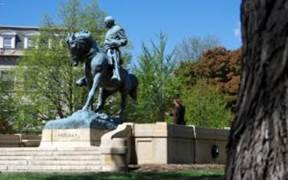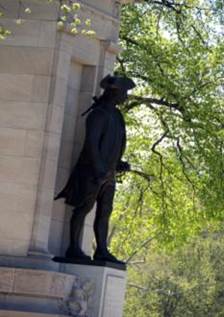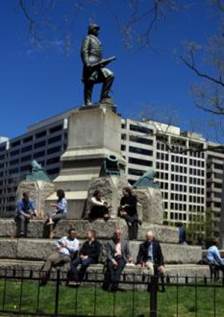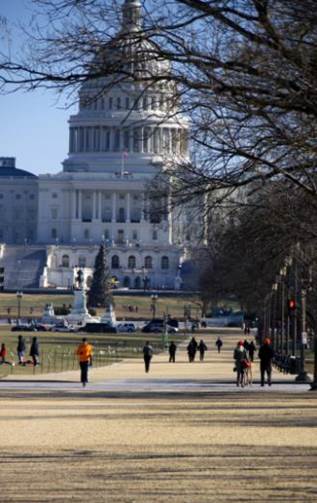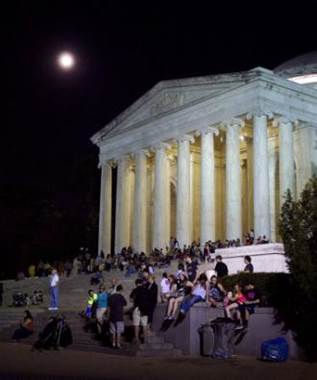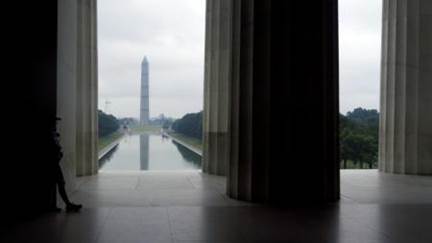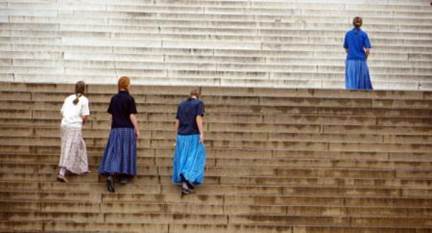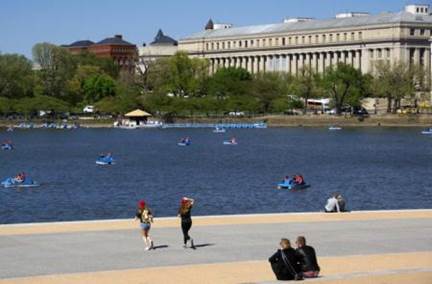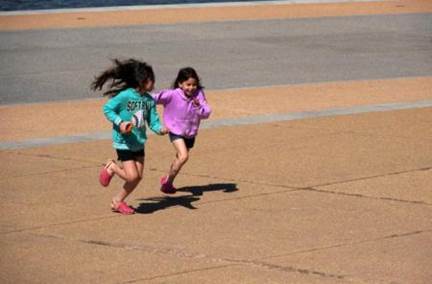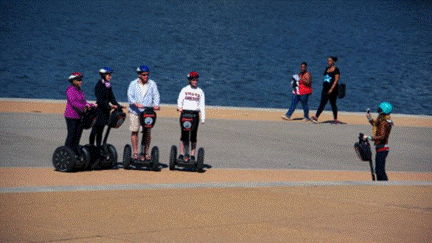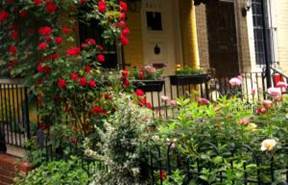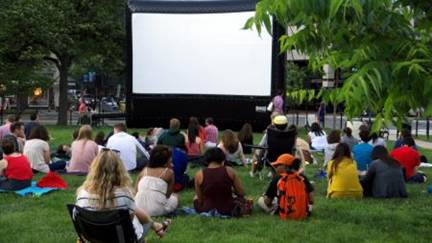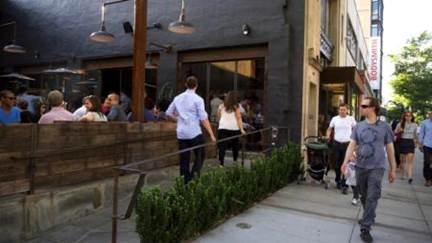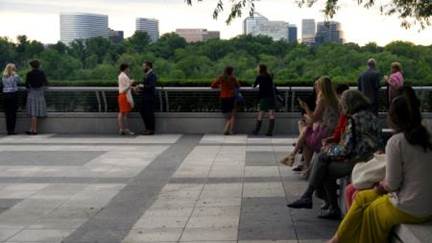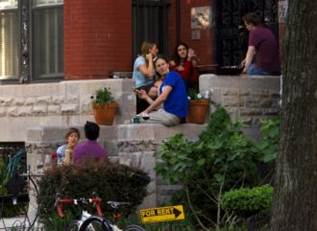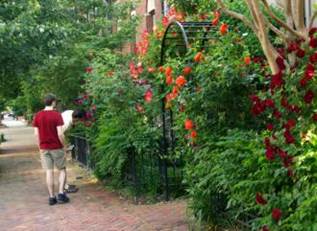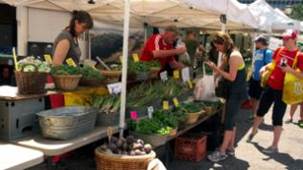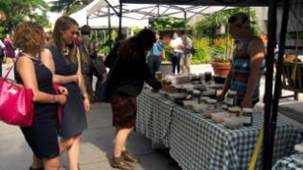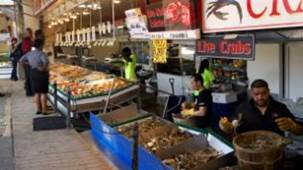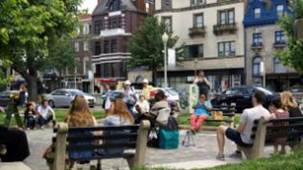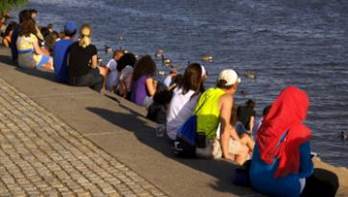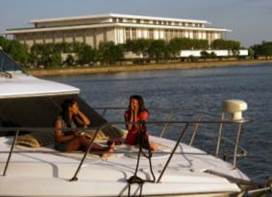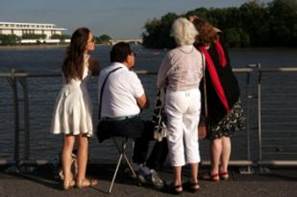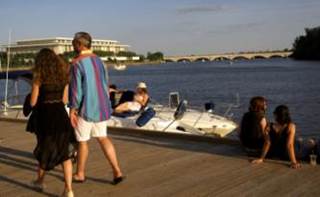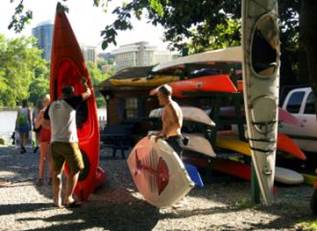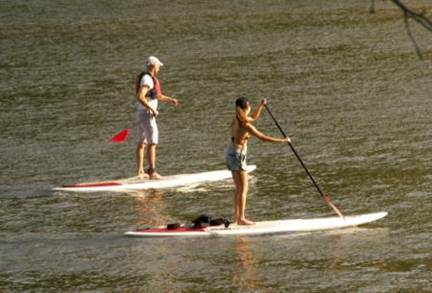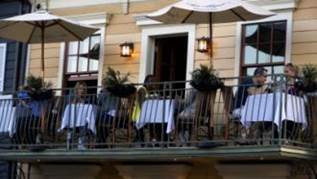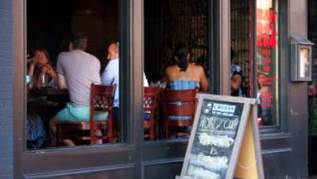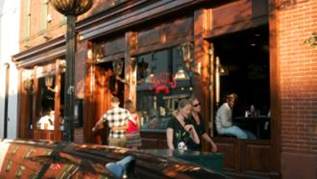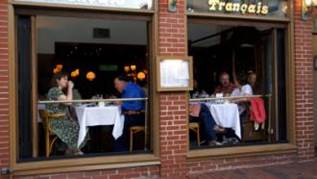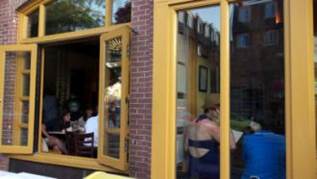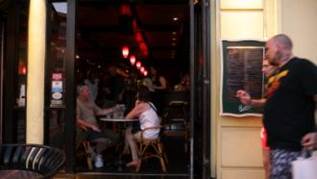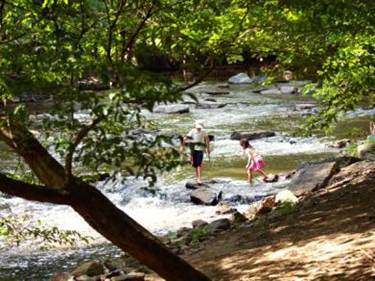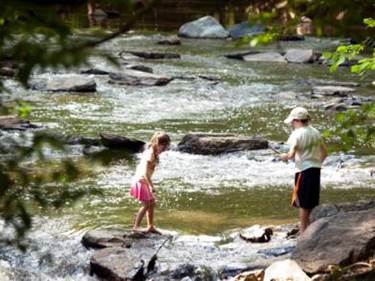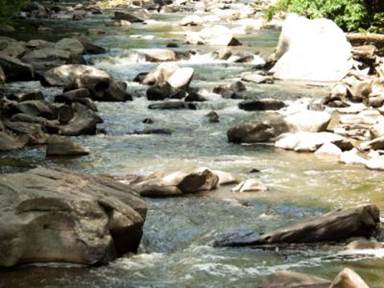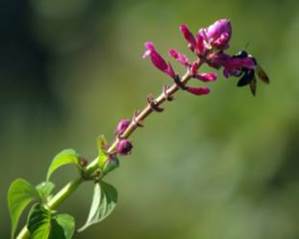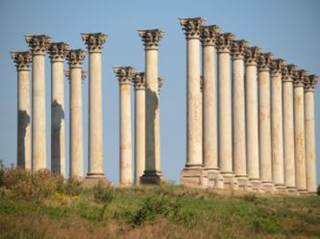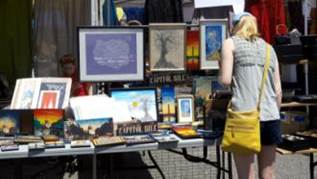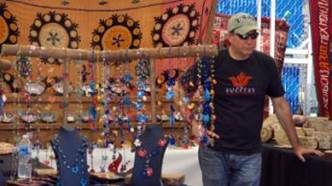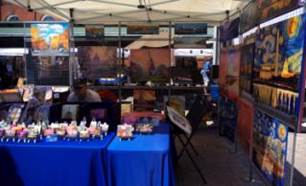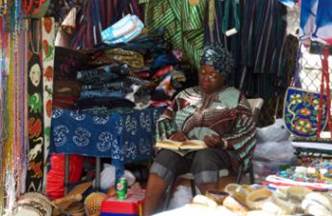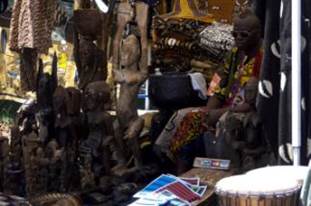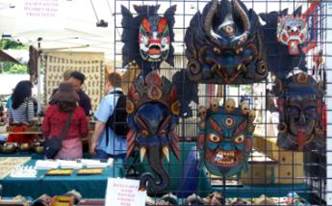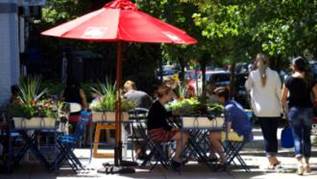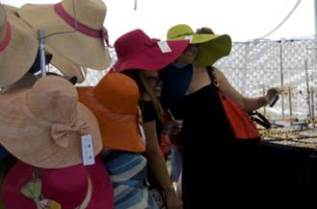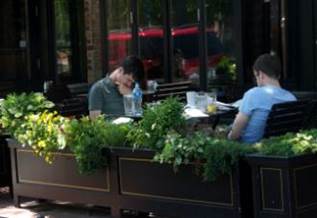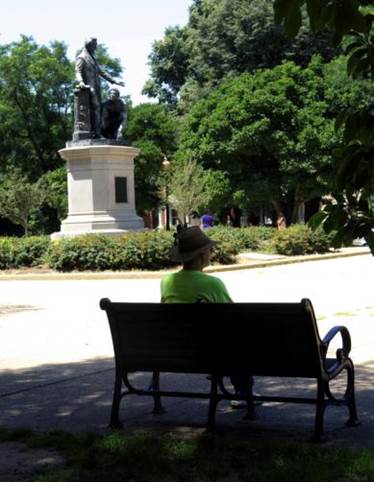|
Washington DC: An Apolitical View I
began to know Washington DC as an outsider. In 2012 I moved to the DC area
for my job. On weekends I’d drive to DC from the suburbs of Virginia to
explore various parts of the city. As I came to see it more often, I fell in
love more with its charming rowhouses, bustling
streets, magnificent stone bridges, and winding Rock Creek. I even grew fond
of those bronze generals I’d meet unexpectedly on a corner or at a turn. I
found the traffic circles troublesome for driving but otherwise intriguing.
They invite the curious to uncover the city’s deep secret. I
am curious. Later after I moved to the city, I’d spend hour after hour
walking many of its neighborhoods. I felt the heartbeat of the city, and my
heart would beat with it. While it is true that dark suits are a fixture of
the capital, the cityscape is also a constant flow of colors. And the city, I
think, is defined more by ordinary people who are here to work and live and
to realize their dreams. A
black woman on the marble stairs of a cathedral wrapped in a white sheet with
the gaze of a supermodel, a middle-aged father and his young son at Dupont Circle playing hide-and-seek at sunset, a homeless
man reading a book in his tent set up above a highway bridge, young couples
deep in conversation strolling in some quiet neighborhood on a Sunday
morning…These are the people who touch me, and I want to sing their
praises. Sometimes, I sit in my small apartment on the ninth floor watching
people on the street march to work and the city life unfold before my eyes while
having my morning coffee. A question would pop into my head. It is a question
human geographers take to their hearts: what defines
a place and its people? I have no doubt that a place influences its people,
and people continuously remake a place. The real question is how. Perhaps my
photos and writing here will offer some insight. Qing Tian Columbia Plaza Foggy Bottom |
|||||||||
|
|
|||||||||
|
Fall for the City… |
|||||||||
|
|
Following
Rock Creek Parkway to Rock Creek Park, the scenery is not only pretty. The
winding roads, the tall stone bridges, the magnificent old trees, and
occasionally a glimpse of the creek, evoke a feel of permanence... |
||||||||
|
|
At
Rock Creek Park, I was so pleased to hear birds singing happily in the city.
It seemed as though I had already known the park long before my first visit.
But somehow on a previous winter day with snowy clouds on the horizon, the
forest’s rolling hills appeared much more grandeur than on this warm spring
day with leaves sprinkling a misty green to veil the Boulder Bridge.
Occasionally I saw a wild cherry tree blossoming among oaks and beeches. The
delicate petals, still fresh, fell scattered on a piece of rotten wood. |
||||||||
|
|
In many of DC’s
neighborhoods from Woodley Park to Dupont Circle,
Adams Morgan, Logan Circle, Columbia Heights… and, of course, Georgetown and
Capitol Hill, these old rowhouses, newly renovated and
more vibrant than ever, stand beautifully to speak the very charm of the
city. I could easily see myself dreaming away on their doorsteps... |
||||||||
|
|
At Dupont Circle, I would watch people come and go.
Intellectuals with thick eyeglasses sit on a bench reading next to the
homeless who drag their sleeping bags around. Two young girls, both white,
play chess with an old black man. No one would notice a guy carrying a
woman’s purse. Even the most elegantly dressed do not look out of place here.
In this part of town, people are united, under the Sea, the Stars, and the
Winds… |
||||||||
|
|
|
||||||||
|
Logan Circle,
located in an historical neighborhood, with beautiful rowhouses
on all sides, is perhaps the finest circle in DC. At its center, surrounded by
oak trees, General John Logan, sporting his fashionable hat, rides a horse
high up in the blue sky. In autumn, when oak leaves change color, sunlight
sifts through tree tops casting a golden hue to green grasses on the ground.
I saw a gray-haired man there smoking a cigar on a bench, his eyes fixed
somewhere else. I knew he has a story. This place has stories too… |
|
||||||||
|
|
|||||||||
|
Kramerbooks & Afterwords Café |
|||||||||
|
Soon I’d
discover Kramerbooks & Afterwords
Café near Dupont Circle. I’d step in to check out
what’s new in the bookstore whenever I walked by. Somebody told me Kramerbooks is very DC, meaning political, presumably.
However, I spotted Doug Hofstadter’s Surfaces
and Essences in its window display the first time I stopped by. I walked
away with Dao De Jing on my second
visit and Hemingway’s A Movable Feast another
time. I noticed that Thomas Piketty’s Capital
in the Twenty First Century stayed in its window display for more than
six months, the longest I have seen, perhaps with the exception of The Goldfinch. While things come into existence because of demand, their existence can then create further demand. Sometimes, people do certain things simply because of availability. I think Kramerbooks is a place that exhibits such “increasing returns.” By the way, its Afterwards Café is quite attractive too. |
|||||||||
|
|
|||||||||
|
|
|||||||||
|
|
|||||||||
|
Simply Charming |
|||||||||
|
Walking on the
brick sidewalks in Georgetown, Capitol Hill and along Florida Avenue, I see children
happy as if in the Garden of Eden, innocent playful youths drawn from a
treasured family photo album, balconies where Romeo and Juliet could have
rendezvoused, and even “Great Gatsbys.” They come
together magically in a dreamy yet real world. But I do not know how to
describe those rowhouses behind tree branches or
creeping vines, drunken in sunlight, quietly and patiently telling the
passing of time. I would not say they are old, though. For a moment I forget
that perpetual and perplexing question of life’s meaning. |
|||||||||
|
|
|||||||||
|
|
|||||||||
|
|
|||||||||
|
|
|||||||||
|
Generals in the City |
|||||||||
|
I
have been living in the city for a year now. Still from time to time I’d run into
a bronze general unexpectedly here and there. I have grown fond of them all,
no matter if he is handsome, cool, obscure, or miserable. I would miss them
if I did not see them for a while. |
|||||||||
|
|
John
Logan occupies the finest spot in the city He
is the coolest general in DC Surrounded
by charming rowhouses and oak trees which
display gorgeous colors in autumn He
rides his pretty horse high up in the blue sky as
pigeons fly at his side He
always wears a fashionable hat Its
decoration has forever changing patterns |
||||||||
|
General Phillip
Sheridan takes up a strategic location and looks stately From a quiet
vintage point under a magnificent
American Elm He and his handsome
horse look down Massachusetts Avenue
where elegant embassies sprawl He has the whole
world in front of him |
|
||||||||
|
|
George Washington
chooses surprisingly to reside in Foggy Bottom He is generous,
often sharing his residence with the homeless despite his Napoleon-styled
gesture and wild horse Even though his
home feels nice behind shades of green He really needs a
larger statue and a more spectacular setting to match his status, I think |
||||||||
|
|
|
||||||||
|
The
navy war hero John Paul Jones watches swarming tourists pass by daily Standing on a marble pylon nestled between the Mall, Tidal
Basin, and the Potomac he looks like a police officer who directs the city’s busy traffic but to whom nobody
pays attention |
David
Farragut does not have a horse The
first admiral in the navy shows off power with
powerful cannons He
is popular too - When
the weather is nice He commands a large fleet He
may enjoy the smell of lobster rolls from food trucks But
I am not sure how he likes the
busy city life in the central business district |
||||||||
|
|
General
Winfield Scott is a miserable fixture in the city Stuck
between some mundane brown buildings he
cannot escape He
turned brown too |
||||||||
|
|
|||||||||
|
Very DC but Apolitical |
|||||||||
|
On a winter Sunday morning, the sun cast warm light on the
Mall after a light snowfall on Saturday. People were walking and jogging with
or without dogs, while trees laid soft shadows on the sand-covered ground. It
looked like the Entrance to the Public Garden in Arles. On a warm spring
evening, men and women, of different ages and colors, gathered on the stairs
of the Jefferson Memorial to watch cherry blossoms peak on the Tidal Basin,
with a full moon watching from above. It made me wonder what the high time of
the Dionysia was like. Following some schoolgirls to the Lincoln Memorial, I
looked out to Washington Monument and its reflection on the reflecting pool.
I did not think of the Founding Fathers. I thought of St. Peter’s Basilica
and the beauty and grandeur of its Corinthian columns…
|
|||||||||
|
|
|||||||||
|
|
|||||||||
|
|
|||||||||
|
|
|||||||||
|
|
|||||||||
|
Alive in Town |
|||||||||
|
Wandering
about in town on a workday in April, I spot professionals grabbing a quick lunch
from the food trucks at Farragut Square and enjoying a conversation with
friends or colleagues. Children are running up the stairs of the Jefferson
Memorial, unleashing their forever renewable energy. A red cape pops up and
flashes by Dupont Circle. Families ride Segways swinging their way around town, with bright blue
and orange hues dotting the Tidal Basin. It warms my heart. |
|||||||||
|
|
|||||||||
|
|
|||||||||
|
|
|||||||||
|
|
|||||||||
|
|
|||||||||
|
|
|||||||||
|
May Again |
|||||||||
|
I
used to buy flowers, lots of them, and arrange them on the balcony of my
apartment in the suburbs of VA to celebrate my special day in May. But this
year I simply stepped out of my place and found beautiful gardens everywhere
in the city before or behind charming rowhouses. I
stopped to smell the roses and smiled. They were all smiling at me too. |
|||||||||
|
|
|
|
|||||||
|
|
|||||||||
|
Friday Evening |
|||||||||
|
A
stroll on a Friday evening does not only reveal some lively social life scenes.
I also come to realize that the character of the city is that of a play,
staged on the stairs of rowhouses, the streets,
entertainment places, public spaces… It can be magical too, like that of A
Midsummer Night’s Dream. Then I come to understand why there are many
theatres in the city and why Tom Stoppard has always been a hot commodity.
The city is no place for A Hundred Years of Solitude. |
|||||||||
|
|
|||||||||
|
|
|||||||||
|
|
|||||||||
|
|
|||||||||
|
|
|||||||||
|
Farmers’
Markets |
|||||||||
|
The
many farmers’ markets in town not only add color to the city but also keep
people in touch with the earth and seas, the sources of life. I’d go there to
see mushrooms of many different shapes and pickles in all sorts of jars. I
would buy fresh Chinese bitter melons and chives with pretty purple flowers.
Sometimes, I’d also enjoy a free performance there while having homemade ice
cream. |
|||||||||
|
|
|||||||||
|
|
|||||||||
|
|
|||||||||
|
The
Waterfront |
|||||||||
|
The
last day of May turned out to be perfect. The waterfront at Georgetown was
very pretty. Since I moved to DC, I have discovered that whatever the city
lacks, it does not lack smart and charming people. Maybe this has to do with
the Potomac. It reminded me of the town of Seward in Alaska where I saw
people smile beautifully, blending into the beauty of their beautiful
environment. I also thought of the village of Sappada
and my friends there who are all as natural as the Dolomites. Perhaps the
Chinese saying makes sense: “The soil and water in a place cultivate its
people. While mountains make people good and wise, water makes people
charming and smart.” |
|||||||||
|
|
|||||||||
|
|
|||||||||
|
|
|||||||||
|
On the Water |
|||||||||
|
The
Potomac is filled with colors in summer. I noticed something new this year:
people are paddling a flat board on the water. From afar one cannot see the
board, and it looks as if Crusoe were floating into the city. It seems really
cool and just right for the free-spirited. And I imagine nothing could be
more relaxing than paddling on the river after a long workday and then
practicing Yoga on the board at sunset. |
|||||||||
|
|
|||||||||
|
|
|||||||||
|
|
|||||||||
|
|
|||||||||
|
Open Up |
|||||||||
|
Georgetown
on weekends is alive everywhere. On the streets flows a dynamic river of
colors as if it were an extension of the Potomac. And the flow moves back and
forth between its waterfront and streets. Restaurants, doors removed or
rolled up, windows pushed inward or outward, open themselves to everybody who
passes by. Even a stranger cannot (who could?) resist such whole-hearted
invitations to come in and sit for a while. It is then hard to tell the
inside from the outside. They all blend together onto one stage where the
play is merry and romantic without central characters. |
|||||||||
|
|
|||||||||
|
|
|||||||||
|
|
|||||||||
|
|
|||||||||
|
Rock Creek in Summer |
|||||||||
|
The
temperament of Rock Creek in summer is cool and tranquil. Under many shades of
beeches, maples, oaks, and hickories, the creek flows at its natural pace -
It is under no pressure to get anywhere. Rocks, no matter in the shade
appearing dark or white in the sunlight, are all content. They are content
just being there. I
have seen kingfishers here flashing their wings over the water as if wingless
and heard pileated woodpeckers beating drums vigorously to announce their
presence. This past May I was overjoyed to be greeted by two wood ducks at
the beginning of my walk in the early morning and then later in the water
near a busy bridge. They seemed so at ease in this place. They must have been
here before. We,
too, have all been here. And we come here from time to time to hear the
sounds of nature, rejuvenated. |
|||||||||
|
|
|||||||||
|
|
|||||||||
|
|
|||||||||
|
|
|||||||||
|
National Arboretum |
|||||||||
|
At
the National Arboretum, it was a delight to see picture-like barks of crape
myrtles (red or white), lacebark pines, and river birches. And I was glad to learn
the differences between pine and cypress in their needle-like vs. scale-like
leaves, and what is a fir, a hemlock, a cedar, a spruce, a larch, or a
tamarack. I was, of course, impressed by the handsomeness of redwoods and the
softness of their flat needles like fur. What impressed me most, however, was
the herb garden where I was surprised to discover sages blooming brilliantly,
and a hummingbird was kissing a red basil flower in mad passion. While
the Capitol Columns, deserted, rest solemnly on a hillock in the Ellipse
Meadow, a yew tree stood alone under the sun. I lifted my eyes to follow its
Gothic shape, and saw a moon face white as a knuckle, with its blue garments
unleashing small bats and owls in the blackness and silence of a churchyard. |
|||||||||
|
|
|||||||||
|
|
|||||||||
|
|
|||||||||
|
Eastern Market
and Arts |
|||||||||
|
Eastern
Market in the Capitol Hill neighborhood is one of the largest farmers’
markets in DC. On weekends, it also includes artwork and crafts featuring local
artists and craftsmen. It is interesting to see a reinterpretation of Chinese
paintings in a Western surreal style. There is originality in the idea to use
pajamas as surrogates of human figures in paintings or in such sayings
printed on plaques as “I love you more than beer,” “It does not do brain
damage to change toilet paper.” While subjects featuring local places or
scenery in DC get various forms of representation, African crafts, Turkey
glass lamps, and oriental antique furniture do not shy away. Bold and quiet
styles of arts coexist, and I have no doubt that each reflects the
personality of its creator. From painting panels filled by dynamic brushes to
faded woodframe mirrors, I see a marriage between
art and utility - like those charcoal drawings of fashion design - though
they may be located in different positions on the spectrum from art to
utility. After all, this is a marketplace, and artists need to make a living
before they can create truly creative art. |
|||||||||
|
|
|||||||||
|
|
|||||||||
|
|
|||||||||
|
|
|||||||||
|
|
|||||||||
|
|
|||||||||
|
Sunday Morning |
|||||||||
|
Sunday
morning on Capitol Hill is bright. I noticed a dominant white and young
population in contrast to the vendors at Eastern Market. The African-American
population in DC has declined steadily since the riots in 1968. Though DC’s
population started to grow again in 2000, the new residents are mostly white.
And many of DC’s neighborhoods are being gentrified. While this neighborhood
transformation has contributed to the growth of the city, making DC even more
attractive to wealthy and young people, it has also created a growing
affordable housing crisis for those lower-income households. |
|||||||||
|
|
|||||||||
|
|
|||||||||
|
|
|||||||||
|
At Lincoln Park |
|||||||||
|
At
Lincoln Park, Lincoln and the educator and activist Mary McLeod Bethune face
each other on opposite sides of the square. While Lincoln holds the
Emancipation Proclamation before a kneeling black man, Mary McLeod Bethune
hands a copy of her legacy to two young black children. Some come to sit for
a while. Some just pass by. Young people are sunbathing on the lawn.
Some families have picnics in the shade. A middle-aged couple enjoys a
relaxing moment. Two women carry on a conversation. A mother watches her two
kids biking. A young father rolls a baby stroller by. An old man, who wears a
hat decorated with feathers, sits with his small funny-looking dog. A young
girl walks by with a dog. The two dogs greet each other. So did the old man
and the young girl. I
cannot help wondering if public spaces like Lincoln Square, Dupont Circle, Logan Circle, and many street parks across
the city, have contributed to integration of people. It may be true that one
comes here mostly to spend a moment alone or with friends or family, but as
people co-exist in this space at the same time, they must at least tolerate
each other. Public spaces may have helped increase acceptance of different
kinds of people. In
1978, Nobel Laureate Thomas Schelling demonstrated, using pennies and nickels
on a paper board, that even when individuals have only a slight preference
for their neighbors to be of their own race, a community could easily settle
into a pattern of segregation. His segregation model thus cast a pessimistic
outlook for integration of society. And the principle of homophily, which is
people from similar backgrounds inclined to interact with each other and more
likely to become friends, found empirical evidence in many social studies.
Furthermore, being friends with similar people reinforces this interaction
pattern. The
notion of “Small World,” which originated from an influential experiment by
the Harvard sociologist Stanley Milgram in 1967, seems to strike a more
optimistic note on social interaction. Milgram randomly chose residents in
Omaha, Nebraska (deliberately picked to be distant from Boston) and asked
them to mail a letter to a stockbroker who worked in Boston and lived in
Sharon, Massachusetts. The participants were given the name of the target
person and certain information about him. They were told not to contact him
directly if a participant did not know the target personally but instead mail
the letter to a personal acquaintance who was likely to know the target
person. It turned out that the average number of intermediaries needed to
reach the target person was five for completed chains. But he was quick to
point out that five intermediaries do not mean five individuals but five
social circles or structures. Integration
of society is not only about race. It also includes integration between the
poor and rich, integration of people from all walks of life, integration
between men and women, etc. Not only does the smooth functioning of society
require inclusion of different kinds of people. The diversity of people also
makes a place interesting. At least some people moved to DC to escape the
life in suburban neighborhoods that are dominated by households of very
similar socioeconomic backgrounds. Integration of society requires tolerance,
appreciation and understanding of people who are different. In fact, we are
all different in some ways. (I
will say more about diversity later. The prosperity of cities depends on
diversity as Jane Jacob argued convincingly, based on her keen observations
of urban life, in the early 1960s. In addition, diversity is closely related
to cooperation, another important topic of social studies and what Prof.
Robert Axelrod’s famous computer tournaments were about. I think we can
better promote cooperation if we emphasize that people are different, and
each can contribute to society in his or her own way. Many of the important
problems our society faces today require cooperation to solve.) |
|||||||||
|
|
|||||||||
|
To be continued... |
|||||||||





















